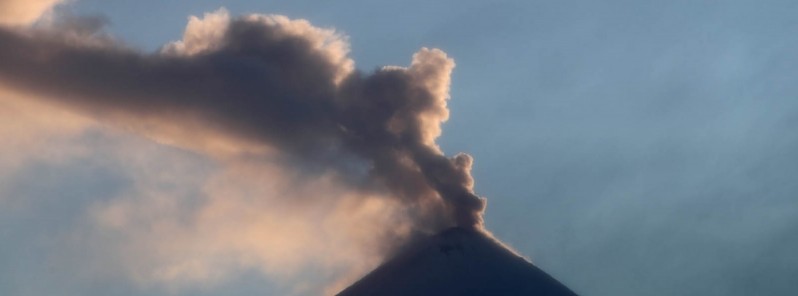Moderately strong eruptions at Klyuchevskoy volcano, ash up to 6 km a.s.l.

Moderately strong eruptions continue at Kamchatka's highest and most active volcano Klyuchevskoy for the third day in a row. The volcanic ash cloud is reaching up to 6 km (20 000 feet) a.s.l. and the Aviation Color Code remains Orange since December 5, 2017.
"A moderate eruptive activity of the volcano continues," KVERT said 05:55 UTC, January 5, 2018. "A gas-steam plume containing some amount of ash drift for about 130 km (81 miles) to the WNW of the volcano.
This series of explosions started on January 3 with volcanic ash cloud reaching a height of 6 km (20 000) above sea level at 03:40 UTC. By 05:06 UTC, ash plume was observed drifting about 90 km (56 miles) E of the volcano.
Kamchatka volcano spits up ash 5-7 kilometers highhttps://t.co/H6B14s9TgT pic.twitter.com/iZEjgkgpZy
— TASS (@tassagency_en) January 5, 2018
Ash plume was reaching an altitude of 5 – 5.5 km (16 400 – 18 000 feet) a.s.l. on January 4, and drifting for about 92 km (57 miles) WNW of the volcano.
The nearest community is the village of Klyuchi, located 30 km (18.6 miles) away from the volcano. Ash falls are frequently observed there during eruptions.
Ongoing activity could affect low-flying aircraft.
Geological summary
Klyuchevskoy (also spelled Kliuchevskoi) is Kamchatka's highest and most active volcano. Since its origin about 6000 years ago, the beautifully symmetrical, 4835-m-high (15 862 feet) basaltic stratovolcano has produced frequent moderate-volume explosive and effusive eruptions without major periods of inactivity. It rises above a saddle NE of sharp-peaked Kamen volcano and lies SE of the broad Ushkovsky massif.
More than 100 flank eruptions have occurred during the past roughly 3000 years, with most lateral craters and cones occurring along radial fissures between the unconfined NE-to-SE flanks of the conical volcano between 500 m and 3 600 m (1 640 – 11 811 feet) elevation.
The morphology of the 700-m-wide (2 296 feet) summit crater has been frequently modified by historical eruptions, which have been recorded since the late-17th century. Historical eruptions have originated primarily from the summit crater, but have also included numerous major explosive and effusive eruptions from flank craters. (GVP)
Featured image: Kyluchevskoy volcano on December 3, 2017. Credit: Yu. Demyanchuk. IVS FEB RAS, KVERT

Commenting rules and guidelines
We value the thoughts and opinions of our readers and welcome healthy discussions on our website. In order to maintain a respectful and positive community, we ask that all commenters follow these rules:
We reserve the right to remove any comments that violate these rules. By commenting on our website, you agree to abide by these guidelines. Thank you for helping to create a positive and welcoming environment for all.